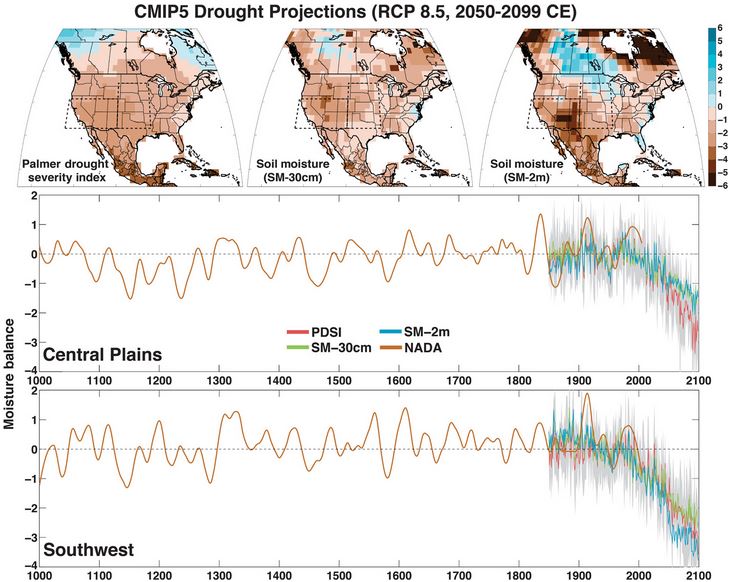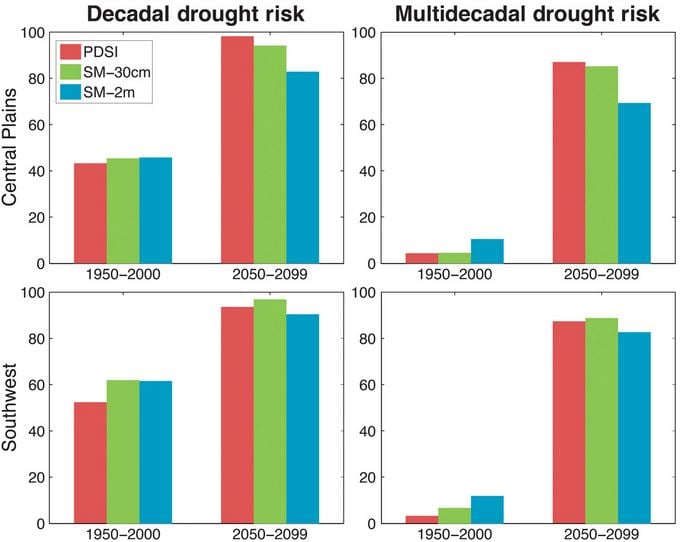The US Southwest and Great Plains will face mega-droughts that will last several decades during the second half of this century, worse than anything seen during the past 1,000 years, said researchers at the Lamont-Doherty Earth Observatory, part of the Earth Institute at Columbia University, and colleagues from other research centers.
The climate scientists say the two regions in the United States will experience droughts worse than anything seen in times ancient or modern, with drying conditions “driven primarily” by global warming caused by human activity.
Toby Ault, Cornell associate professor of earth and atmospheric sciences, said:
“The results were striking. As a society, we’ve weighted the dice toward mega-drought. Data clearly point to a high risk in the Southwest and Great Plains, as we continue to add carbon dioxide into our atmosphere. However, if we manage to get serious about lowering greenhouse gases within the next 10 years, we could face a lower risk.”

According to their findings, the scientists predict multi-decades-long droughts affecting two vast regions of the US after 2050 (Image: Science Advances)
Their study has been published in the online journal Science Advances (citation below).
Worse than any droughts in the last 1,000 years
The predicted drying will exceed in severity any of the “mega-droughts” that have afflicted the region during the past 1,000 years. They will be even more severe than the one some scientists linked to the decline of the Ancient Pueblo Peoples (Anasazi) in the Colorado Plateau seven hundred years ago.
While several studies have forecast that the US Southwest could dry as a result of global warming, this is the first one to predict that conditions will be worse than anything seen in the distant past.
With the high populations currently living in the two US regions, the impact could be absolutely devastating, the researchers warn.
Co-author Jason E. Smerdon, a climate scientist, said:
“We are the first to do this kind of quantitative comparison between the projections and the distant past, and the story is a bit bleak. Even when selecting for the worst megadrought-dominated period, the 21st century projections make the megadroughts seem like quaint walks through the Garden of Eden.”
Lead author Benjamin I. Cook said:
“The surprising thing to us was really how consistent the response was over these regions, nearly regardless of what model we used or what soil moisture metric we looked at. It all showed this really, really significant drying.”

The risk of droughts lasting several decades increases considerably after 2050 (Image: Science Advances)
Droughts already affecting the American West
In much of the American West, including Arizona, New Mexico, Nevada and California, 11 of the last 14 years have been drought years. Across the Southern Plains to Texas and Oklahoma, similar periods of drought have been recorded, says the US Drought Monitor, a collaboration of government agencies.
In the Southwest and Southern Plains today, drought affects over 64 million people directly, says NASA, with several millions more – mainly farmers – affected indirectly.
Dwindling water supplies have forced western states to introduce water usage restrictions; aquifers are being drawn to unsustainable levels, while key surface reservoirs such as Lake Powell and Lake Mead are at record-low levels.
In February, the Los Angeles Department of Water and Power reported that the winter’s snowpack in the Sierras, a vital source of water for Los Angeles and nearby cities, is less than one quarter of a “normal level”.
In 2014, hundreds of thousands of acres of agricultural land in the Central Valley were left unplanted because the water flow from the northern part of California to the south was cut off by officials.
Climate researcher Kevin Anchukaitis said:
“Changes in precipitation, temperature and drought, and the consequences it has for our society–which is critically dependent on our freshwater resources for food, electricity and industry – are likely to be the most immediate climate impacts we experience as a result of greenhouse gas emissions.”
“(The findings) require us to think rather immediately about how we could and would adapt.”
Lamont-Doherty scientist Edward Cook (Benjamin Cook’s father), who had carried out extensive studies of tree rings, created the North American Drought Atlas in 2009. Much of scientists’ knowledge of past droughts comes from Mr. Cook’s research.
His Atlas recreates the history of drought over the past 2,005 years, based on the chronologies of hundreds of tree-ring readings, gleaned in turn from tens of thousands of tree samples across the whole of North America.
For the latest study, the scientists used data from the Atlas to represent past climate, and applied three different drought measures – a version of the Palmer Drought Severity Index, which gauges precipitation, evaporation and transpiration, and two soil moisture measurements at several depths.
While some have wondered how accurate the Palmer Drought Index might be regarding soil moisture, the scientists found it correlated well with other measures. Mr. Cook said it “provides a bridge between the [climate] models and drought in observations.”
The team applied seventeen climate models to analyze the future impact of rising average temperatures on the areas. They also compared it to different global warming scenarios: 1. One with “business as usual”, forecasting greenhouse gas emissions volumes continuing to rise and contributing to global warming. 2. A scenario where emissions are moderated.
By most of those measures, they reached the same conclusions.
David Stahle, professor in the Department of Geosciences at the University of Arkansas and director of the Tree-Ring Laboratory there, said:
“The results … are extremely unfavorable for the continuation of agricultural and water resource management as they are currently practiced in the Great Plains and southwestern United States.”
Prof. Stahle was not involved in the study, but worked on the North American Drought Atlas.
Smerdon and colleagues say they are confident in their results. They wrote:
“The effects of CO2 on higher average temperature and the subsequent connection to drying in the Southwest and Great Plains emerge as a “strong signal” across the majority of the models, regardless of the drought metrics that are used. They are consistent with many previous studies.”
According to Anchukaitis, the paper “provides an elegant and convincing connection” between reconstructions of previous climate and models indicating the risk of future drought.
Citation: “Unprecedented 21st century drought risk in the American Southwest and Central Plains,” Benjamin I. Cook, Toby R. Ault & Jason E. Smerdon. Science Advances. 01 Feb 2015: Vol. 1 no. 1 e1400082 DOI: 10.1126/sciadv.1400082.
NASA Video – Multi-Decade Mega-Droughts Predicted
